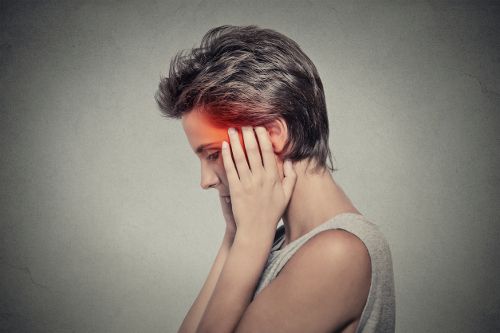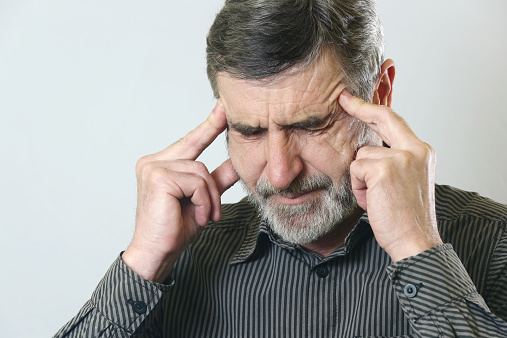
Credit: iStock.com/SIphotography
At one time or another, we have all experienced dull or stabbing pains in the left temple of the head.
Usually, pain in your left temple is caused by tension, stress, sinus issues, or even consuming cold products such as ice cream too fast.
In certain cases, your left temple pain can be caused by a more serious issue such as temporal arteritis, temporomandibular joint syndrome (TMJ), a brain tumor, or a stroke.
Before you attempt to treat a headache or pain pulsating in the temple of the head, it is important to understand the possible cause and note any other symptoms.
We shall investigate what causes pain in the left temple and how to treat pain in left temple.
In this article:
What Causes Pain in the Left Temple of the Head and How to Treat It?
1. Temporal Arteritis affects the temporal arteries that stem from the neck’s carotid artery. Although there is no concrete reason as to why these arteries become inflamed, researchers believe a person’s low functioning immune system is the cause.
Along with a pain in the left temple, people report fever, sweating, muscle weakness and aches, loss of appetite and fatigue as symptoms. It is treated with steroids.
 2. Tension-induced pain is caused by stress, lack of sleep or food, poor posture, and muscle tension. The temporary pain feels like pressure is being applied to the temple and has no other symptoms.
2. Tension-induced pain is caused by stress, lack of sleep or food, poor posture, and muscle tension. The temporary pain feels like pressure is being applied to the temple and has no other symptoms.
Treatment is usually over-the-counter pain medication, meditation, yoga or massage. Long-term prevention suggestions include drinking plenty of water, a diet rich in omega-3 fatty acids, and proper posture and an ergonomic workstation.
3. Occipital Neuralgia headaches are caused by damage or injury to the nerves located at the base of the skull.
Sharp, stabbing pain in the left temple of the head can be accompanied by sensitivity to light and to touch.
Initial treatment includes rest, over-the-counter pain pills, and a heating pad on the neck.
Depending on the strength and time-length of the pain, your doctor may prescribe muscle relaxants, strong pain medications, or injections of nerve blockers and steroids.
4. Temporomandibular Joint Syndrome pain can be caused by damage or injury to the joint that connects your jaw to your skull and is classified by inflammatory joint issues, internal joint derangement, and myofascial pain.
This can happen with injury to your teeth or jaw, grinding, stress, gum chewing, and even arthritis.
Treatments include ice packs, massage, over-the-counter pain medications, dental splints, Botox injections, or surgery.
5. Sinus pain evolves from inflamed membranes around the sinus cavity. The pain of the left temple can also radiate to the eyes, cheeks, and across the forehead.
Treatment is usually over-the-counter pain relivers or a prescribed medication.
6. Stroke episodes can present a sharp pain in the left temple accompanied by muscle weakness and numbness, especially in the arms, and slurred speech.
Treatment is dependent on the response time and any damage to the body.
An overall healthy lifestyle complete with exercise, diet, and good health can help prevent a stroke from occurring.
7. Migraine pain can literally knock a person off their feet as physical movement, sounds, and light can cause the severe pain to become worse.
Other symptoms include tingling sensations, nausea, vomiting, and vision issues such as flashes of light.
Treatment varies from rest, meditation, pain relievers, and prescription remedies to long-term treatments such as Botox.
Many migraine sufferers also have abnormally low levels of magnesium in the body.
The University of Maryland Medical Center notes several studies which suggest that the use of magnesium could decrease the recurrence of migraine attacks in those with magnesium deficiency.
In fact, one particular study found that people who took magnesium lowered the frequency of attacks by 41.6%. Those who took placebo saw a 15.8% dip in comparison.
It must be noted that magnesium can have an effect on certain prescribed drugs such as muscle relaxers, diuretics, antibiotics, and heart medications.
8. Brain tumors may be the first thing some people fear with severe pain of the head.
While there are many other causes of this type of worsening pain, a brain tumor also has symptoms of vision, speech, and hearing difficulties as well as nausea and vomiting, and changes in behavior patterns.
Treatments vary depending on the tumor and can include surgery, radiation, chemotherapy, and drug therapy.
9. Cluster headache pain affects men four times more than women and attacks usually around the same time daily over a period of several weeks.
Intense, constant pain is usually followed by a runny nose with red, watery eyes.
This condition is rare and is treated with pain relievers, oxygen, and prescribed medication.
10. Nummular headaches may also cause pain in the left temple of the head. This rare form of head pain covers a circumference of one to six centimeters in size.
The mild to severe pain may vary but never falters from the originating area.
The sharp, stabbing pain may present as a constant pressure with accompanying symptoms of numbness, tingling, or tenderness to the touch.
11. Cervicogenic headaches in the left temple region are often distinguished by their occurrence with a sharp positioning of the head and neck. This type may also result from holding the neck in one position for a prolonged period of time.
The headache may present as a constant pain that is felt in this region of the head and possibly on the left side of the face.
The pain may last up to a few days and may intensify with a deep breath, sneeze, or cough.
A stiffness in the neck can also accompany the headache as can nausea, vomiting, or sensitivity to light.
12. Giant cell arteritis may cause a left temple headache, and is also referred to as cranial arteritis, temporal arteritis, and Horton disease. The blood vessels within the region become inflamed and restrict the blood flow.
This rare condition may also cause the shoulders and neck to become rigid or stiff, fever, chewing difficulty, and temple headache. A direct cause is not known.
13. Ice-pick headaches are temporary but cause overwhelming pain in the temple and eye region.
Associated with cluster and migraine headaches, this pain is not directly caused by any disorder or health issue.
There is no specified treatment due to the short time they last, but you should visit your doctor if you have constant jabs of pain near your eyes.
14. Food-induced headache pains in the left temple of the head are linked to the ingredients monosodium glutamate, nitrates, and sulfites within the food consumed.
This includes spices, seasonings, wine, chocolate, processed meat and canned foods, and food served in some Chinese restaurants and take-outs.
The pain may be accompanied by muscle tension, breathing difficulty, and excessive sweating. Reaction to the food usually is noticeable within the first half hour of consuming the elements.
Common Headache Treatments to Help Treat Pain in Left Temple

Minor or infrequent headaches usually are no cause for concern and can be treated by various home remedies. Before you reach for your over-the-counter pain reliever, try some of the following suggestions.
- Rest quietly in a dimly lit room.
- Place a cold compress to the affected area.
- Unwind in a hot bath or shower.
- Take a walk in fresh air.
- Work through a stress headache with a
moderate exercise routine. - Consume foods rich in fiber, protein, and
vitamins. - Massage lightly the affected area
- Take deep, long breaths to fill the lungs with
oxygen.
Just like many health concerns, reoccurring or severe headaches should be checked out by a medical professional.
While most headaches are caused by poor eating habits, fatigue, stress, and poor posture, it can also be a symptom of an underlying health issue.
When to See a Doctor
Pain in the left temple may be an indication of a serious underlying health condition and may require medical attention.
A noticeable length of time of the pain, the severity, one’s gender and age, and accompanying symptoms should be considered with left temple pain.
A lasting headache pain that is not alleviated by natural remedies, or by the use of an over-the-counter medication, should not be ignored.
If the pain is sudden and excruciating, seek medical attention immediately.
Mild to severe headaches of any sort may be a serious concern once you reach the age of 50. Women of this age should take special precaution to seek medical advice with a headache as there is a higher risk of blood vessels rupturing, causing a cerebral aneurysm.
Pay Attention to Pain in the Left Temple of the Head
A pain in the left temple of the head can present as a dull ache or may be severe enough to cause a disruption to daily activities, and may last for days.
Most cases are caused by temporary tension, stress, or a mild case of a sinus infection. These headaches can be easily treated by resting in a quiet, dark room, or by taking deep breaths in fresh air with a walk.
Severe pain in the left temple may require medical attention as it can be caused by an underlying health condition that needs to be addressed with prescribed medication or medical procedures.
The timing, lasting effects, severity, and any accompanying symptoms with a left head temple pain are indications of whether the cause is acute or chronic.
Also Read:
- When Pain in the Right Temple Is Something Worse than a Headache
- Morning Headaches: The Causes and How to Treat Them Naturally
- 10 Homeopathic Remedies for Headaches
- Understanding Sharp Pains in the Head
- Top 5 Essential Oils for Headaches
- 10 Homeopathic Remedies for Headaches
- My Head Feels Heavy: Causes and Treatments for Heaviness in the Head
Article Sources (+)
Doherty, C., MD, “What is a Nummular Headache?” Very Well, April 29, 2017; https://www.verywell.com/parietal-headache-may-be-a-nummular-headache-1719428, last accessed September 26, 2017.
“What is a Cervicogenic Headache?” WebMD; http://www.webmd.com/migraines-headaches/cervicogenic-headache-facts_#1, last accessed September 26, 2017.
“Pain in Left Temple of Head,” Hello Mr. Doctor; http://hellomrdoctor.com/pain-in-left-temple-of-head/, last accessed September 26, 2017.
